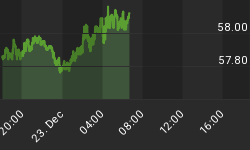Below is an extract from a commentary originally posted at www.speculative-investor.com on 15th February 2007.
Few commentators on the financial markets have a better understanding of inflation/deflation than Paul van Eeden. We do, however, take issue with the following extract from Mr van Eeden's 28th January commentary (http://www.paulvaneeden.com/pebble.asp?relid=641):
"In a hypothetical situation of monetary inflation with no change in the production of goods and services, prices would increase in direct proportion to the inflation rate: a 10% increase in the supply of money would cause a 10% increase in prices for all goods and services."
If inflation actually did operate in the way described above then it would be much less problematic than it is in the real world. To be specific, if inflation (growth in the supply of money) resulted in a uniform increase in prices throughout the economy in proportion to the rate of money-supply growth then anyone with basic math skills could easily anticipate its effects and plan/act accordingly. For example, lenders and savers could ensure that they weren't being disadvantaged by inflation by demanding that interest rates be adjusted in proportion to the rate of change in the money supply; and salaried workers would know exactly how much their salaries would have to be increased each year to ensure that they weren't going backwards in real terms. Also (and perhaps most importantly), it would be relatively easy to determine which price increases were due to inflation and which were due to other factors, meaning that price -- the mechanism via which information on what to produce and how much to produce gets transmitted through the economy -- would still provide reliable guidance to the producers of goods and services.
In the real world, however, inflation almost always operates in a non-uniform manner in that some prices don't rise at all in response to the inflation whereas other prices experience disproportionately-large increases. Furthermore, the non-uniformity itself is non-uniform in that the prices that are first to move and that move the most in response to inflation during one cycle will often be amongst the latest/slowest movers during the next cycle. At least, this is the way inflation tends to operate prior to the point where confidence in the official currency breaks down completely.
An effect of the above-described non-uniformity is that price signals become confused, leading to the misdirection of investment and, eventually, to a general fall in productivity (businesses respond to price signals as they always do, but they have no way of knowing whether prices are rising due to inflation or due to a real need for greater supply). Another effect is that the link between cause (money supply growth) and effect (a fall in the purchasing power of the money) becomes obscured, resulting in attention being diverted away from the true source of the problem.
The difficulty of seeing the link between cause and effect made possible by the non-uniform way in which the effects of inflation spread through the economy is what makes inflation both sustainable over long periods and desirable -- desirable, that is, from the point of view of those who want the ability to gain votes by making promises that can only be financed via inflation and those who are in a position to financially benefit from the inflation.
As mentioned by Mr van Eeden in the above-linked commentary, the large and growing wealth gap is a consequence of inflation. This is because the people who will generally be in a position to benefit from the inflation -- at least, up until the point where monetary confidence begins to decline at an accelerated pace -- are the ones who are already well-off, whereas those at the lower rungs of the economic ladder will be hit the hardest by the associated declines in productivity and real wages. There's some irony here in that a large chunk of the inflation stems from financing the Welfare State, and yet the very people that the Welfare State purports to help are the ones who tend to be most disadvantaged by inflation. But, of course, there is nothing unusual about the actual effects of a government program being the opposite of the intended effects.
Like many of the problems sharing the same cause, barely one in one-thousand people will correctly view the growing wealth gap as a consequence of the inflationary policies implemented by the central bank and the government. Therefore, to the extent that the wealth gap becomes a political football we should expect that the proposed 'solutions' will involve government programs designed to improve the lots of the groups perceived to be amongst the most disadvantaged; that is, we should expect the proposed solutions to involve more inflation-financed government spending.
Which brings us to our final point: inflation sets in motion a positive feedback loop in that it causes problems and these problems are used to justify more inflation, which leads to bigger problems, and so on. But this loop could not exist if the link between inflation and the pernicious effects of inflation were readily apparent to most people. That the link is not readily apparent is, in turn, a consequence of the non-uniform way in which inflationary effects ripple through the economy.















